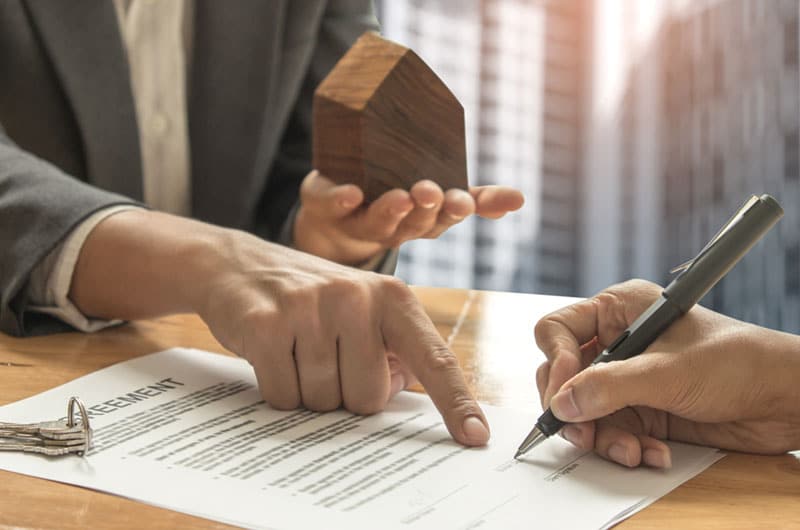Buying a house can feel like a minefield, with so much to learn and so many steps to the process. We’re here to make one easier for you. Learn what the conveyancing process involves here…
At its simplest, the conveyancing process involves three-stages:
- A notional buy or sell agreement
- An exchange of contracts
- Completion of the transaction
Stage One: A notional buy or sell agreement

The start of the first phase is triggered when a buyer and a seller finally settle on a price and instruct their solicitors to proceed with the property conveyance. An estate agent usually updates everyone with the transaction details and, where relevant, will organise energy performance certification.
On the seller’s side there are Property Information and Fittings & Contents forms to complete, plus a sale contract to prepare. These are sent to the buyer’s solicitor accompanied by proof of title evidence and any other key documents relating to register information. A buyer’s solicitor will usually respond at this stage with specific queries based on the documentation received. From the buyer’s perspective, this is the moment when the sale finances must be put in place. If there is a to be mortgage finance, then offer confirmation must be obtained from the mortgage provider. In addition, the buyer must decide whether a basic property survey (often arranged by the lender) will suffice, or whether it is wiser to pay for a more thorough and detailed buyer survey which may, for example, advise on hidden property defects.
According to the particular property, the purchaser’s solicitor has various searches to conduct via the local authority, the environmental agency and other bodies. And depending on the area, there may be other more particular searches (e.g. mining enquiries) which may be appropriate. Should the purchase be subject to a ‘transaction chain’, the conveyancing of each and every property in the chain must be complete before any of the parties can move forward. All must have finance agreed, plus searches concluded and enquiries resolved, before any contracts can be exchanged.
Stage Two: An exchange of contracts

The conclusion of all preceding steps clears the way for the solicitors for both parties to determine a completion date and then conduct an exchange of contracts. This communication usually takes place via the telephone. In complex chain transactions, any party who must sell in order to buy can generally arrange to exchange both sets of contracts simultaneously on the designated completion date already agreed between all chain participants.
When the exchange of contracts occurs, the buyer is at once liable to pay a non-returnable deposit – usually amounting to 10% of the agreed purchase price. However, in cases where a buyer must also conclude a sale, the monies from that sale transaction can be used to furnish the requisite deposit.
Any agreed completion date will invariably be a weekday and anything from 2-4 weeks after the respective solicitors have exchanged contracts. In most circumstances, this will also be the designated moving date. In the meantime, the buyer’s solicitor will draft the sale transfer document for seller approval and then signature by both transacting parties.
Where there are mortgage arrangements, the purchasing solicitor will supply details to the mortgage lender in advance of the completion date. Once the lender is satisfied that all necessary mortgage protocols have been observed, funds will be made available so that the transaction can proceed.The purchase solicitor’s final duty at this stage is to collect any balance of funds the buyer may have undertaken to provide under the agreed sale terms, and complete a final search of land charges and the land registry.
Stage Three: Completion of the transaction

When the completion day arrives, the seller’s solicitor will receive the transaction funds from the buyer’s solicitor. This process is conducted by telegraphic transfer. So in any chain transaction, there will be a pause whilst each individual transaction completes in turn.
Having received purchase funds, the sell-side solicitor’s next task is to authorise the release of the keys to the property – usually held by the appointed estate agent. Then the solicitor will pass the transfer of property on to the buyer’s solicitor together with any ancillary documentation (e.g. title deeds) which may be required. At this point, the seller’s solicitor will arrange any necessary mortgage redemption and then prepare a final account for the seller detailing the proceeds of the sale, less any charges and fees.
The purchasing solicitor’s final task is to pass any stamp duty due on the transaction through to the Inland Revenue, accompanied by a land transaction return. The Revenue will then issue a certificate which will enable the purchasing solicitor to approach the land registry to officially register the new buyer’s title and so complete the sale transaction.
That’s it! Your simple guide to buying a house and what the conveyancing process involves!

